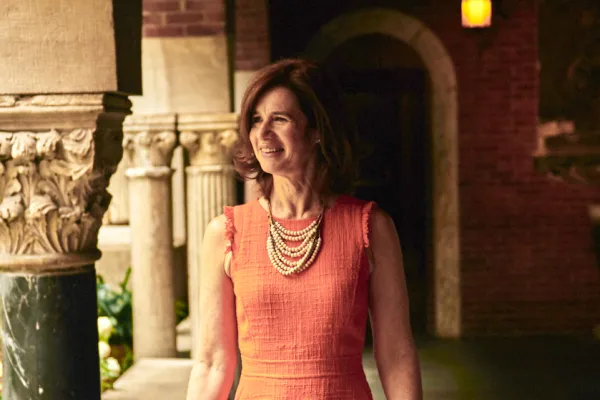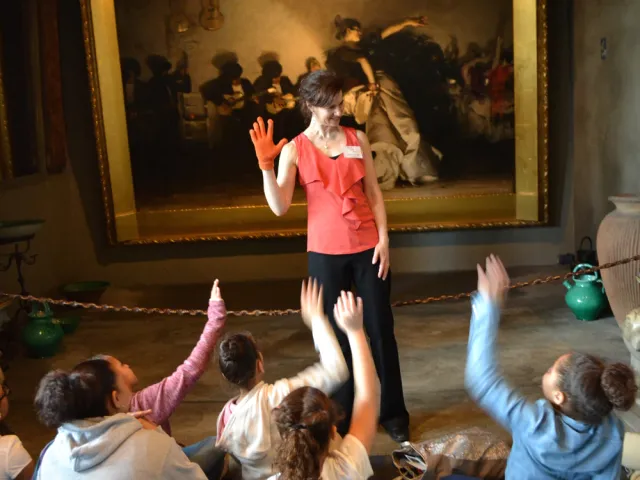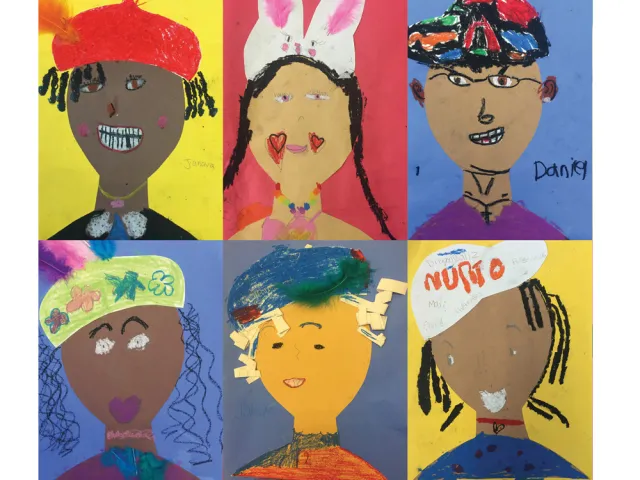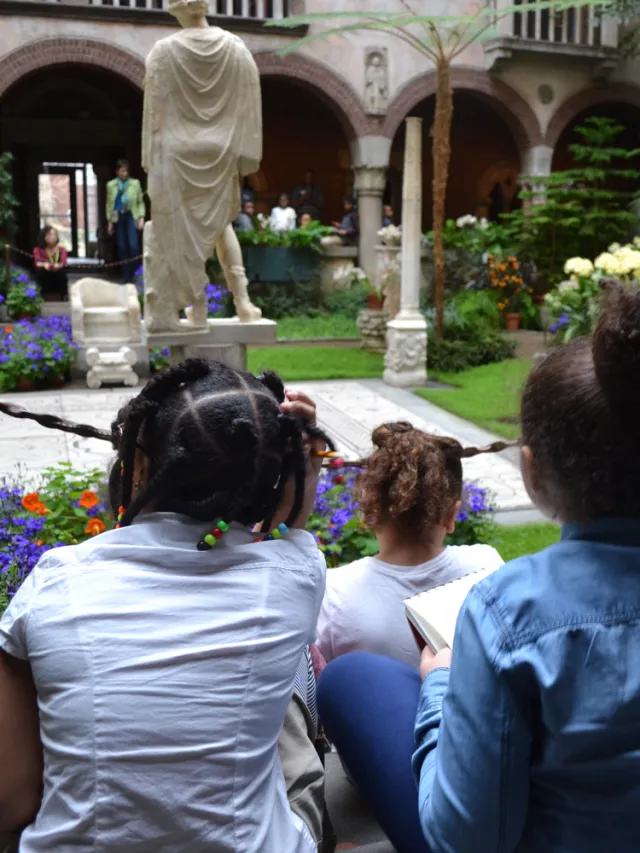Abigail Rischin ’86: Step Into Art
Alum News

Published December 9, 2019
The Harvard Art Museums in Cambridge are a seven-mile drive from Mother Caroline Academy, a tuition-free middle school for girls in the heart of Boston’s Dorchester neighborhood. But they might as well be a world away. For most of the 18 Mother Caroline sixth graders milling about on the museums’ granite steps on this cool October morning, this would be their first visit to a world-class museum, and their first chance to see original masterworks by artists like Pollock, Picasso and van Gogh.
Museum newbies, perhaps, but these girls knew those painters.
As part of Step Into Art, a program founded by Abigail Rischin ’86, they had spent classroom time learning about the artists: how they worked, details about their lives, why their work is important. They had talked about how Jackson Pollock’s action paintings capture the release of emotions he experienced while creating them. And then they created their own version by expressively flinging yarn pieces at a large canvas. “Those kinds of active learning experiences are very much in the spirit of the Step Into Art model,” Rischin says. “It gave the girls an active, tactile experience that built a memorable connection to the Pollock.” When they encountered Pollock’s No. 2 (1950) in the Harvard gallery, it was like finding a familiar friend.
Step Into Art brings children into great museums, giving them the confidence to feel “a real sense of belonging there.”
For Rischin, who partners with Boston schools that serve primarily economically disadvantaged students, Step Into Art is all about cultural access. “Not just getting kids inside the doors of the museum but enabling them to be there in a way that makes for a really positive and meaningful experience,” Rischin says. “It offers them the chance to experience the world of a great museum and to come equipped with personal connections and knowledge that give them a real sense of belonging there, and a sense of excitement.”
Rischin launched Step Into Art in 2005, but the spark came several years earlier, when she would spend Sundays with her young daughters, Emily and Julia, in Boston’s Museum of Fine Arts (MFA). “They were sketching in the galleries, and we were absorbing every sort of public program that came through,” she recalls. “I was making mental notes about things that I thought were interesting.” Later Rischin created a program for Julia’s first grade class in advance of a museum visit. “The kids got to act out paintings and dance them and listen to music and discuss them in all sorts of ways before seeing the paintings in person at the museum.”

Abby Rischin asks children to find an orange handprint somewhere in John Singer Sargent’s El Jaleo at Boston’s Isabella Stewart Gardner Museum. Photograph by Jennifer Duckett ’14.
She began offering vacation-week enrichment programs in suburban Newton, where she lives, but then she read about a tuition-free school in Boston and its mission of serving economically disadvantaged children. That’s when her dream truly took shape: She would use the cultural treasures of Boston’s museums to bring fine art to youngsters in a way that would also allow the children to express themselves creatively, in both words and images. And she would incorporate it into the school day. Today she works with third grade classes at seven Boston public schools, along with the sixth grade girls at Mother Caroline and, starting in January, sixth grade boys at tuition-free Nativity Prep.
“They create these beautiful sensory poems about what it feels like to step into a painting.”
“The public schools we partner with are all Title I schools, meaning that more than 40 percent of the students are eligible for free or reduced lunch,” she says. In all, about 500 schoolchildren a year take part in Step Into Art.
Besides working with the Harvard Art Museums, Rischin regularly partners with Boston’s MFA and the more intimate Isabella Stewart Gardner Museum. During museum visits, Rischin is a blur of activity as she shepherds youngsters through the galleries, visiting particular paintings along the way. As they gather around her, she asks questions: What does Picasso’s blue paint signify? (“Sadness.”) What do you notice about van Gogh’s shoes? (“They’re old and worn out.”) What is Kerry James Marshall doing in this painting? (“He’s painting himself because the paint on his brush is the same black as his skin.”) Can you hold a pose like Degas’ Little Dancer? (They can and they do.) Rischin hands out sketch pads and invites the Mother Caroline girls to draw whatever artwork calls out to them. She wants them to feel comfortable in this quiet and formal space, but part of that is knowing the rules. Sixth graders learn how to carry their museum stools, keeping them a safe distance from precious works of art. Younger students get a lesson on “the museum walk.” “They have to walk with their hands clasped … looking around carefully,” Rischin says. “They get tons of compliments from visitors because they do such a great job at the museum.”
In another exercise, the students translate their experiences and observations into poems. “They create these beautiful sensory poems about what it feels like to step into the world of the Gardner Museum courtyard, or of a specific painting. What they see, what they feel and who they want to pretend to be,” Rischin says. “It’s really moving to see all the children—including kids who might otherwise be resistant to writing—just jump in. Every hand is up to share their work.”
By the end of the program—which concludes with a celebration—each student has a sketchbook of their drawings and a book of the class’s collected poetry. At one school, the poetry and artwork become a collage that is part of a growing exhibition at Boston’s Codman Square branch library.

These Rembrandt-inspired self-portraits by third graders from Lee Academy decorate the children’s room of the Codman Square branch of the Boston Public Library.
Step Into Art began as a solo project, but over the years Rischin has created a team of part-time teachers, administrators and interns. In 2016, for instance, she hired Jennifer Duckett ’14, then a graduate student in arts education. As an intern, Duckett gained tools for her own career and was impressed by how thoroughly the program engaged young children, who she calls “the next generation of artists, curators and visitors.” “Their joy and their ease in these spaces is exactly what I hope to see in every art museum across the country,” Duckett says.
For Rischin, the payoff comes when she encounters a former student visiting a museum on their own or when she sees a child really responding to the artwork. She remembers an 8-year-old saying all her stress went away while looking at art, and another little girl who, while sketching in the enclosed courtyard garden of the Isabella Stewart Gardner Museum, began to cry. “She told the teacher she never thought anything real could be so beautiful,” Rischin says.
She also paraphrased a note from a parent, who, after thanking Rischin for introducing the Gardner Museum to her daughter, went on to say, “We used to drive by that museum all the time, and it seemed like it was just a place with long lines. Now it’s a place where my daughter feels at home and wants to share with her community.”
This story appears in the Winter 2019-20 issue of the Smith Alumnae Quarterly.
SMITH ID
ABIGAIL RISCHIN ’86 Founder and president, Step Into Art
SENIOR HOUSE: Northrop
MAJORS: English language and literature, French studies
FURTHER EDUCATION: Doctorate in comparative literature from Yale
SMITH’S INFLUENCE: “Art 100 has had a lot to do with how I teach Step Into Art programs. It opened the world to me, seeing all the works from all over the world and from so many different centuries, and then having the chance to see so many of those works in person during my junior year in Paris. It was an incredible experience.”
PAINTERLY POETRY

Photograph by Jennifer Duckett ’14
When a place is as beautiful and inspiring as the lush courtyard of the Isabella Stewart Gardner Museum in Boston, a simple description doesn’t do the trick. So when Abby Rischin brings third graders there, she teaches them about the descriptive magic of a well-constructed simile. The youngsters respond with beautiful couplets, like these composed by Jade and Chahd of East Boston’s Guild Elementary:
When I step into the courtyard,
I hear voices as quiet as the night-time breeze.
Or this:
When I step into the courtyard,
I see statues as inspiring as a well-known story.
Writing about artwork connects the children to a long literary tradition, Rischin says. And it echoes her own academic work at Smith, where she wrote her English honors thesis on Robert Browning’s painter poems.
“There is a long narrative thread in my own life and education that connects with the creative work I’m now doing with all these fantastic kids,” Rischin says.
Photograph by Tony Luong